translation services
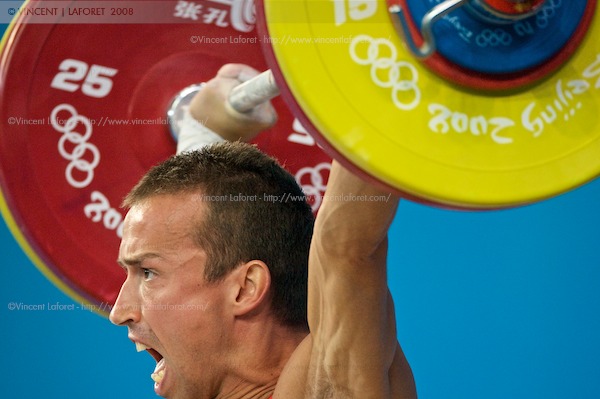
Photograph by Vincent Laforet for NEWSWEEK
I’ve got to confess something: I slept through my first Olympic assignment yesterday. Yep, IT happened. I got done completing my first blog at 6 a.m. on Saturday morning, after a day that had lasted 22 hours. I knew I was in bad shape as soon as my head hit the pillow, because my wake-up call was set for 7 a.m. I never heard the alarm go off. Luckily I didn’t miss anything terribly important. I also knew that I had to photograph the women’s fencing match that evening that the U.S. eventually swept all of the medals in, and I would have been pretty worthless on one hour of sleep anyway. At least that’s my excuse. Why am I telling you this? Well, just to admit that IT does happen. And because we’re supposed to give you a peak “behind the curtain” in this blog. So far I’ve slept a total of 7 hours in the past two days, and that will be pretty consistent for the next two weeks. That being said, you just better be able to count the amount of times IT happens on one hand during your entire career.
So I tried to make amends today by going back to the venue that I was supposed to go to yesterday and I photographed the Men’s 56 Kg. preliminaries in weightlifting. The problem is: Donald is photographing the finals of weightlifting tonight, which means I should have headed to another venue this morning: ANY other venue (in the interest of providing you guys with a good variety of images.) The problem is we decided to change from our carefully pre-planned schedule last night, and at 3:50 a.m. weight lifting looked pretty good to me on the schedule. I didn’t see that Donald was already assigned to the finals in the evening, and covering this event would allow me to get almost 4 hours of sleep and make it to the venue in time. So I’m having a bit of a rough start at these Olympics—but that’s good because it can only go up from here. Morale is still very high.
As you may know from my first blog posting, I’m a bit of a gear head. Gear doesn’t make the picture, but it can allow you to make a frame that you otherwise wouldn’t be able to. To make the frame at the top of this blog (above,) I was able to borrow an 800mm 5.6 lens from Canon (both Canon and Nikon set up shot at the main press center and loan equipment to photographers, as well as make repairs on site, which is priceless!) The 800mm is a lens that’s just been released by Canon and I really wanted to see what I could pull off with it. One of the reasons that this lens is useful is that there are only 4-5 of them here at the Olympics—and what that means is that there are very few other photographers who will be shooting with it. Why does this matter? Because you can shoot from positions that others aren’t in (because they are shooting with different (shorter) lenses…) and this gives you a little more breathing room, and a better chance of making a unique frame. The Olympics are all about trying to make frames that no one else is making—and that’s something that’s very difficult to pull off when you’re competing with the best 1,500+ sports photographers in the world.
The lens was a blast to use—it’s incredibly sharp and it allowed me to push myself a bit and shoot the picture above full-frame. I was standing about 30 feet away from the weight lifters, which is ridiculously close for an 800mm. The picture is of Turkish weightlifter Sedat Artuc who made it through qualifications. These guys are truly amazing to watch!
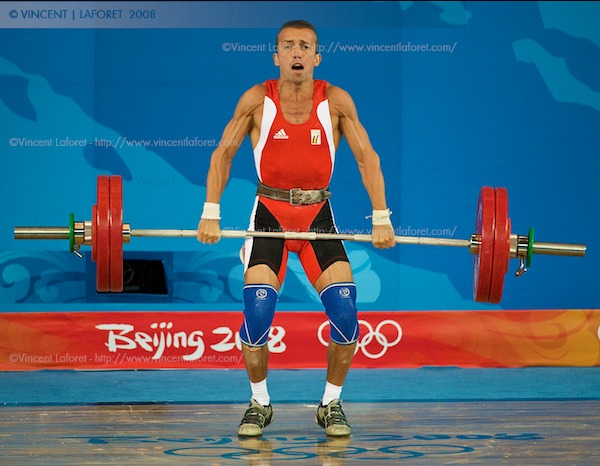
Photograph by Vincent Laforet for NEWSWEEK
Just look at the veins bulging out of Tom Goegebuer’s arms! And the expressions you get … the guy below… well, he looks like he’d rather be anywhere in the world but under those weights right about now… he’s managed to get the weights up… now what? I’m sure the release must be as terrifying as the lift. The weights are almost 3 times their body weight.
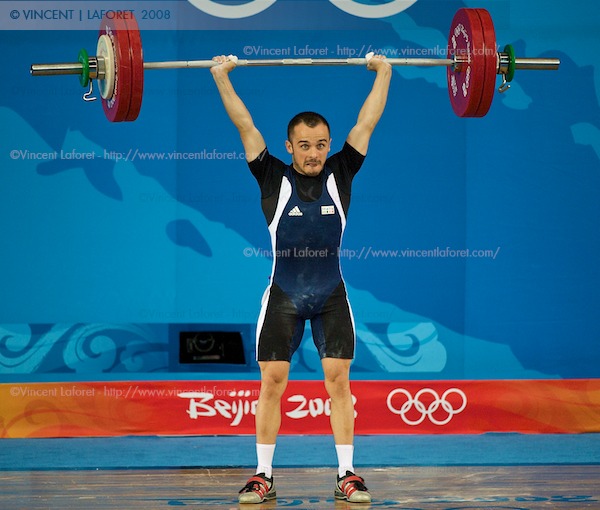
Photograph by Vincent Laforet for NEWSWEEK
Vito Dellino didn’t quite make it through the qualifications…
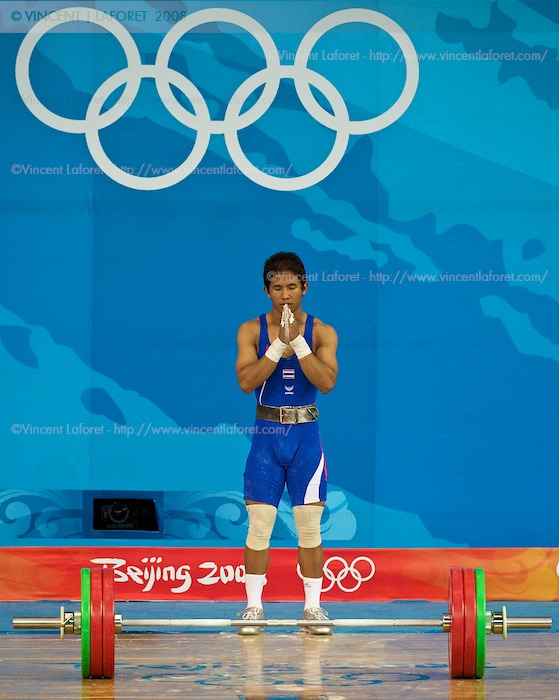
Photograph by Vincent Laforet for NEWSWEEK
Pongsak Maneetong of Thailand asked for a little help from above… and it worked.
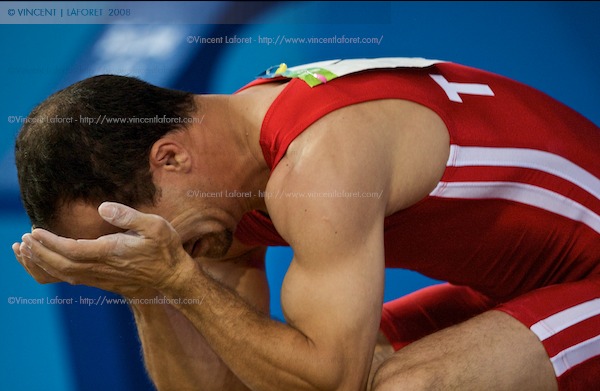
Photograph by Vincent Laforet for NEWSWEEK
Sedat Artuc of Turkey – was not so lucky. He didn’t make it through either. Each wright lifter has three lifts to make it to the next round.
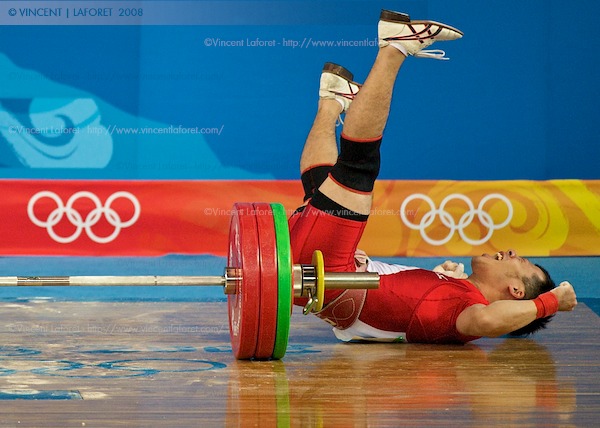
Photograph by Vincent Laforet for NEWSWEEK
Masaharu Yamade of Japan was thrilled when he made his lift, falling to the ground in celebration. Man, I wish I had an overhead remote for this picture… unfortunately you need to make a formal request one full day in advance, and show up hours before the start of the event to set up that remote… which means you have to find the time to go to that venue the day before to make that request formally, and in writing, which is impossible, unless you’re going to the same venue two days in a row. There are so many forms and request here in China… the bureaucracy is unbelievable.
Speaking of bureaucracy, my quote of the day from a driver who dropped us off 500 yards from the Main Press Center: “I’m sorry, I must comply to regulation,” the young man told us when we asked why he couldn’t bring us any closer… need I mention that this exchange took place in the middle of a torrential downpour.
Back to photography, I also had a chance to cover the finals of the synchronized swimming event at the National Aquatics center.
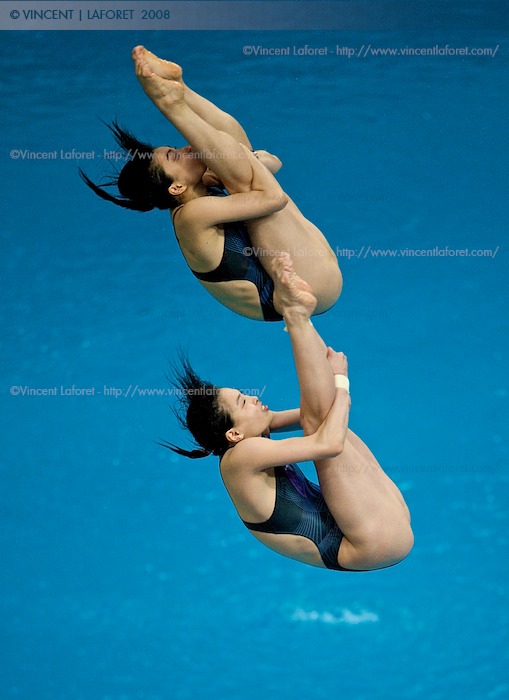
Photograph by Vincent Laforet for NEWSWEEK
Guo Jingling and Wu Minxia took gold in the competition.
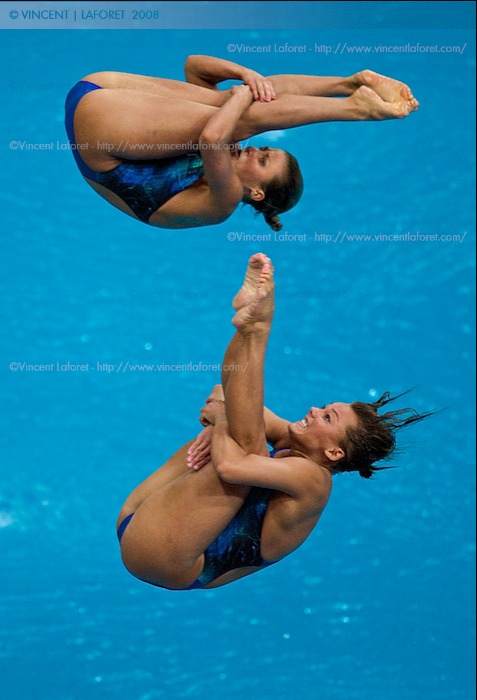
Photograph by Vincent Laforet for NEWSWEEK
The German diving partners Ditte Kotzian and Heike Fischer were not quite as perfect and took home the bronze.
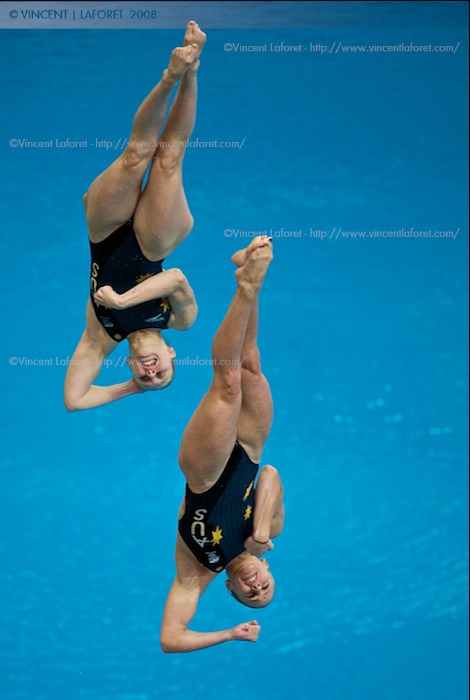
Photograph by Vincent Laforet for NEWSWEEK
The Australians (who were well in the running for the medals) also fell short and did not metal at all.
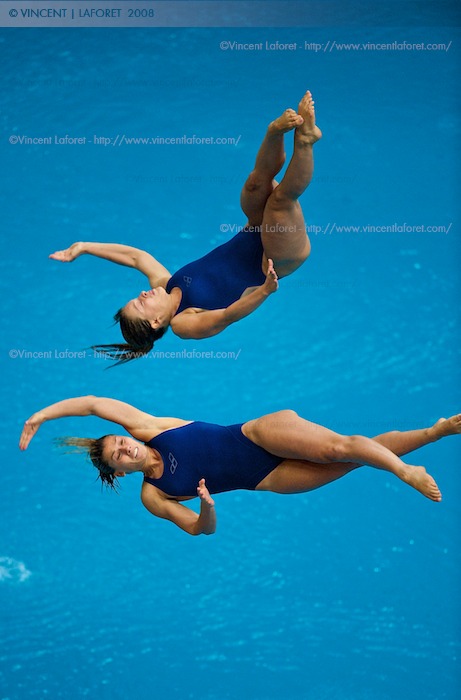
Photograph by Vincent Laforet for NEWSWEEK
But the Italian team took the cake in terms of the worst dive from today—Noemi Batki and Fanscescan Dallape have had better days I’m sure…
All in all it was a good day. I would have liked to play with more motion blur with the diving, but the backgrounds are very ugly in this venue, and we’re only allowed to shoot from two positions in this event—both on either side of the diving boards. It really doesn’t give us much to work with creatively. I’ll have to figure out something different to do for the other diving events that I cover from here on.
One of the toughest things we have to do as photographers here at the Olympics is not only to come up with fresh new ideas for images, but also to find and negotiate ways to make them happen. There seem to be fewer and fewer photo positions with each Olympics—when they tell you you need to shoot in this “box,” that’s exactly where you can shoot from, not one foot to the left or right of it.
I’ll leave you with the following anecdote: In order to make the first frame atop this blog, I wanted to shoot from an angle that was 3 feet lower than the “official” photo position. These were spots reserved for television cameras. Given that it was a preliminary round, there was only one television station occupying one of the 10 spaces down there. And we had maybe 8 photographers in the entire arena (that could easily accommodate 200 still photographers.)
So I asked one of the photo marshalls if I could move down three feet to make the frame—the background would work better. He told me that it was “not possible.”
I then asked if I could please speak with the Photo Venue Manager (the person in charge of photographers and positions). And was told she was “busy.”
I asked once again—very nicely. And 10 minutes later the manager showed up.
“Would it be possible for me to move down there—3 feet for a few minutes to make a different frame?”
“I’m sorry but this isn’t an official photo position,” she said, very matter-of-factly.
“But I wouldn’t be blocking anyone’s view, and the TV positions are almost completely empty.”
“I’m sorry but I can’t allow you to go there—it is reserved for television only,” she said.
“You’re sure I couldn’t even go down there even for just a few minutes. It surely won’t bother anyone.”
“No—if I let you go, then other photographers will follow,” she replied.
“But there are only 8 of us here today—it’s nearly empty—surely this won’t be a problem…”
“But you might get in the way of someone and we cannot let this happen,” she continued, unrelenting.
“What if I promise to move if I get in anyone’s way, and to move if you ask me to for any reason whatsoever…”
Long pause.
“You promise?”
“Absolutely—just for a few minutes.”
“OK—but just this once and only for a few minutes.”
So I did manage to get to that special angle—and before I could reach the bottom of the stairs two other security guards were on me within 5 seconds flat, telling me that I was not in an “approved photo position.”
And it all started all over again—this time with the venue manager in charge of television. You get the gist. This is what we have to go through every day—and living in a box is not something ANY photographer likes to do. And that can be one of the most frustrating things one deals with at these Olympics—thinking of an original image, finding a way to make it happen—the right gear, the right position and timing—and even though that position is sitting unused, not ever being able to reach it.
A little charm, politeness, and perseverance is the best recipe for success in these situations—but I’ve got to say it’s not nearly as effective here in China as it has been with prior Olympic hosts… when they tell you “No” here – 99% of the time you’re going to have to take that as their final answer.
*A note about the hedline for the curious reader: ‘Dream team” is how director of photography Simon Barnett affectionately refers to NEWSWEEK’s Olympic photographers.












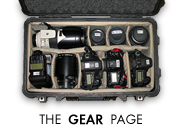

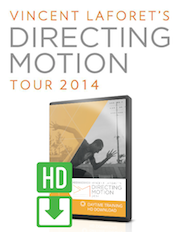








I was reading you blog on Newsweek (which is FANTASTIC) and watching the Olympics at the same time when I had a weird twilight moment.
I had just started reading about the synchronized diving and was looking at the picture of Guo Jingling and Wu Minxia, when their names were called on TV. I was able to watch them dive on TV and view their picture at the same time (they actually just dove agin). It is amazing to be able to read about behind the scene events while the Olympics are taking place. Please keep up the good work. I feel that your blog adds a sense of reality that our culture has started to lack. Thank you!
Vincent, thanks for taking the time to write this blog and give us some insight to how things are going over there. The inner workings and reality behind your images is fascinating.
Am glued to the Olympics on TV along with your blog. Thank you so very much. Kaity said it all.
Oops… Well there go three “attaboys” right out the window….
I did that once but Kate Jarvis was nice enough to call me and wake me up! Take some B vitamins, it helps me a lot on my 200 mile rides!
Your photos are sight for soar eyes. You’re doing amazingly great having so little sleep. Well, who would sleep any way during this great Olympic Games where the energy of competition is on the highest level.
You rock dude!